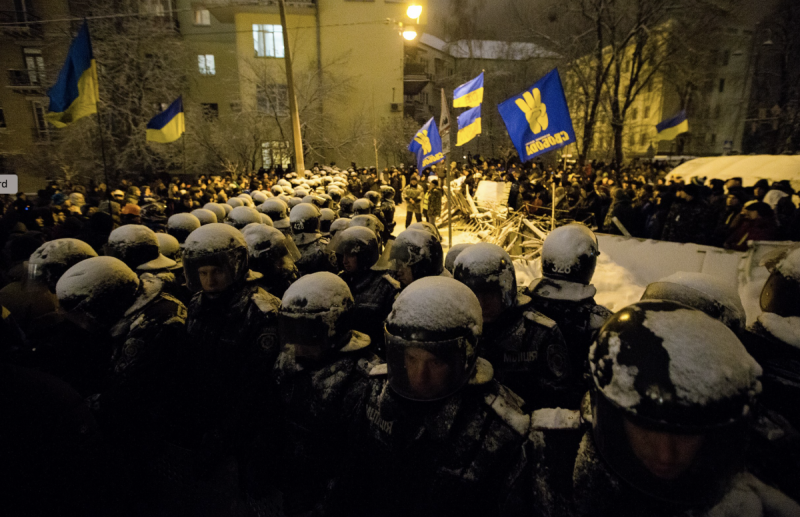Helen ROWE
Thu, December 22, 2022

Gender imbalance in shouldering domestic work is explained by different ways in which men and women perceive chores, philosophers at Britain's Cambridge University suggest.
Women looking at an unclean surface may see something to be wiped whereas men may just observe a crumb-covered countertop, researchers argue in the journal Philosophy and Phenomenological Research.
They say data gathered during the pandemic, when both men and women spent time at the domestic coalface, throw up two important questions -- why women continue to take on most housework and why men believe it to be more equally shared than it is.
According to a survey of US households during the pandemic, 70 percent of women said they were fully or mostly responsible for housework, and 66 percent for childcare, roughly the same proportion as usual.
Tom McClelland, from Cambridge University's department of history and philosophy of science, said the fact that inequalities persisted and that many men continued to be oblivious meant that traditional explanations were not the whole story.
The researchers say "affordance theory" in which people experience objects and situations as having actions implicitly attached could explain the disparity.
According to the study, when a woman enters a kitchen, she is more likely to see dishes to be washed or a fridge to be stocked.
But the study was not about absolving men or making excuses, they said.
Perception is shaped on practice and people can train themselves into good habits, McClelland told AFP.
"If you're boiling the kettle, look to see if there are any crumbs that need wiping up. Over time you won't need the routine because the crumbs will start to grab your attention... They'll call out to be wiped up and you won't need to be so deliberate."
McClelland said the study was aimed at understanding such phenomena from an academic perspective and influencing policy areas such as paid paternal leave.
"One of the important things about parental leave is it's not just about the distribution of caring work during the early months of a child's life it's about how those early months tune you in to caring tasks in the future," he said.
"If a man has more extended parental leave, he'd be more tuned into those caring needs... and that would lead into more equitable distribution of caring and labouring in the future."
Men may not ‘perceive’ domestic tasks as needing doing in the same way as women, philosophers argue
Philosophers seeking to answer questions around inequality in household labour and the invisibility of women’s work in the home have proposed a new theory – that men and women are trained by society to see different possibilities for action in the same domestic environment.
They say a view called “affordance theory” – that we experience objects and situations as having actions implicitly attached – underwrites the age-old gender disparity when it comes to the myriad mundane tasks of daily home maintenance.
For example, women may look at a surface and see an implied action – ‘to be wiped’ – whereas men may just observe a crumb-covered countertop.
The philosophers believe these deep-seated gender divides in domestic perception can be altered through societal interventions such as extended paternal leave, which will encourage men to build up mental associations for household tasks.
Writing in the journal Philosophy and Phenomenological Research, they argue that available data – particularly data gathered during the pandemic – suggest two questions require explanation.
One is “disparity”: despite economic and cultural gains, why do women continue to shoulder the vast majority of housework and childcare? The other is “invisibility”: why do so many men believe domestic work to be more equally distributed than in fact it is?
“Many point to the performance of traditional gender roles, along with various economic factors such as women taking flexible work for childcare reasons,” said Dr Tom McClelland, from Cambridge University’s Department of History and Philosophy of Science.
“Yet the fact that stark inequalities in domestic tasks persisted during the pandemic, when most couples were trapped inside, and that many men continued to be oblivious of this imbalance, means this is not the full story.”
McClelland and co-author Prof Paulina Sliwa argue that unequal divisions of labour in the home – and the inability of men to identify said labour – is best explained through the psychological notion of “affordances”: the idea that we perceive things as inviting or “affording” particular actions.
“This is not just looking at the shape and size of a tree and then surmising you can climb it, but actually seeing a particular tree as climbable, or seeing a cup as drink-from-able,” said Sliwa, recently of Cambridge’s philosophy faculty and now at the University of Vienna.
“Neuroscience has shown that perceiving an affordance can trigger neural processes preparing you for physical action. This can range from a slight urge to overwhelming compulsion, but it often takes mental effort not to act on an affordance.”
There are dramatic differences in “affordance perception” between individuals. One person sees a tree as climbable where another does not. Objects offer a vast array of affordances – one could see a spatula as an egg-frying tool or a rhythmic instrument – and a spectrum of sensitivity towards them.
“If we apply affordance perception to the domestic environment and assume it is gendered, it goes a long way to answering both questions of disparity and invisibility,” said McClelland.
According to the philosophers, when a woman enters a kitchen she is more likely to perceive the “affordances” for particular domestic tasks – she sees the dishes as ‘to be washed’ or a fridge as ‘to be stocked’.
A man may simply observe dishes in a sink, or a half-empty fridge, but without perceiving the affordance or experiencing the corresponding mental “tug”. Over time, these little differences add up to significant disparities in who does what.
“Affordances pull on your attention,” said Sliwa. “Tasks may irritate the perceiver until done, or distract them from other plans. If resisted, it can create a felt tension.”
“This puts women in a catch-22 situation: either inequality of labour or inequality of cognitive load.”
This gender-based split in affordance perception could have a number of root causes, say philosophers. Social cues encourage actions in certain environments, often given by adults when we are very young children. Our visual systems update based on what we encounter most frequently.
“Social norms shape the affordances we perceive, so it would be surprising if gender norms do not do the same,” said McClelland.
“Some skills are explicitly gendered, such cleaning or grooming, and girls are expected to do more domestic chores than boys. This trains their ways of seeing the domestic environment, to see a counter as ‘to be wiped’.”
The “gendered affordance perception hypothesis” is not about absolving men say Sliwa and McClelland. Despite a deficit in affordance perception in the home, a man can easily notice what needs doing by thinking rather than seeing. Nor should sensitivity to domestic affordances in women be equated with natural affinity for housework.
“We can change how we perceive the world through continued conscious effort and habit cultivation,” said McClelland. “Men should be encouraged to resist gendered norms by improving their sensitivity to domestic task affordances.
“A man might adopt a resolution to sweep for crumbs every time he waits for the kettle to boil, for example. Not only would this help them to do the tasks they don't see, it would gradually retrain their perception so they start to see the affordance in the future.”
Collective efforts to change social norms require policy-level interventions, argue the philosophers. For example, shared parental leave gives fathers the opportunity to become more sensitive to caring-task affordances.
Added Sliwa: “Our focus has been on physical actions such as sweeping or wiping, but gendered affordance perceptions could also apply to mental actions such as scheduling and remembering.”
JOURNAL
Philosophy and Phenomenological Research
ARTICLE TITLE
Gendered affordance perception and unequal domestic labour
Male gender bias deters men from some career paths
Jobs in early education and other fields impacted, study finds
Peer-Reviewed PublicationMen are less likely to seek careers in early education and some other fields traditionally associated with women because of male gender bias in those fields, according to research published by the American Psychological Association.
Bias against men in health care, early education and domestic (HEED) fields has been documented in prior research, and the current study sought to gauge the impact of that bias.
In one experiment with 296 online participants from the U.S., one group read an article accurately describing research that found educators preferred a female elementary school teacher applicant over a male applicant with the same qualifications. Another group read an article that claimed there was gender equality in early elementary education, and there was a control group that didn’t read any article.
Men in the group that read about male gender bias anticipated more discrimination in early elementary education and felt less sense of belonging, less positive and less interest in pursuing a career in that field. Female participants weren’t affected and reported similar responses across the different groups.
An experiment with 275 students at Skidmore College had similar findings. The research was published online in Journal of Experimental Psychology: Applied.
While female gender bias in STEM (science, technology, engineering and math) fields has received much public attention, male gender bias in HEED careers has been largely ignored, even though it also has negative impacts, said lead researcher Corinne Moss-Racusin, PhD, an associate professor of psychology at Skidmore College.
“It’s a detriment to society if we keep slotting people into gendered roles and stay the course on gender-segregated career paths, regardless of whether those jobs are traditionally associated with women or men,” she said. “That’s a powerful way of reinforcing the traditional gender status quo.”
Men account for only 3% of preschool and kindergarten teachers and 13% of registered nurses in the U.S., according to the U.S. Bureau of Labor Statistics. In prior research, male nurses have reported higher levels of workplace bullying than female nurses. Male early-elementary teachers have reported higher rates of discrimination and are perceived as less likeable, less hirable and a greater safety threat to children than female teachers.
Rooted in traditional views of motherhood, the stereotype that women are more caring and naturally suited for some care-oriented professions limits opportunities for men in those fields, Moss-Racusin said.
“There’s no evidence that men are biologically incapable of doing this work or that men and women are naturally oriented toward different careers,” she said. “Both men and women are deterred by gender biases they may face in different industries, which is understandable.”
Men also may be deterred by the low pay commonly found in HEED fields, which may be related to discrimination against women and a devaluing of work associated with them, Moss-Racusin said.
More recruitment and mentoring of men in HEED fields could help reduce gender bias and lead more men to seek careers in those fields, she said.
Article: “Gender Equality Eliminates Gender Gaps in Engagement with Female-Stereotypic Domains,” by Corinne A. Moss-Racusin, PhD, Samantha A. Rapp, BA, Sophie S. Brown, BA, Kerry A. O’Brien, BA, Skidmore College, and Alyssa Croft, PhD, The University of Arizona, Journal of Experimental Psychology: Applied, published online Dec. 22, 2022.
Contact: Corinne Moss-Racusin, PhD, may be contacted at cmossrac@skidmore.edu.
JOURNAL
Journal of Experimental Psychology
SUBJECT OF RESEARCH
People
ARTICLE TITLE
Gender Equality Eliminates Gender Gaps in Engagement with Female-Stereotypic Domains
ARTICLE PUBLICATION DATE
22-Dec-2022



